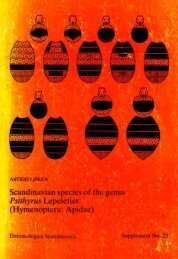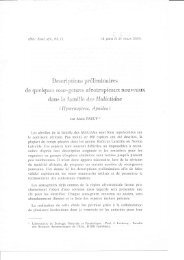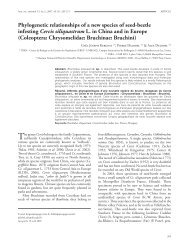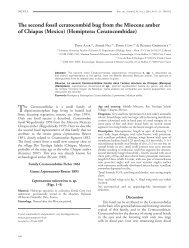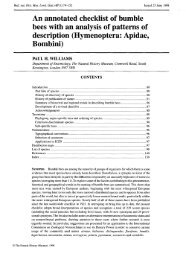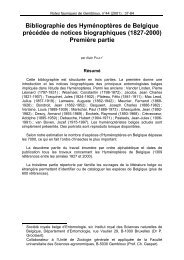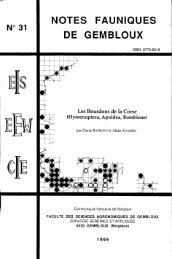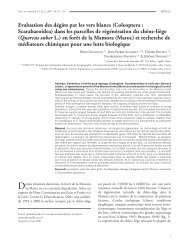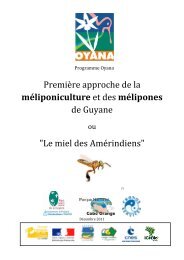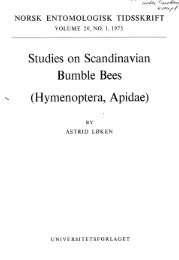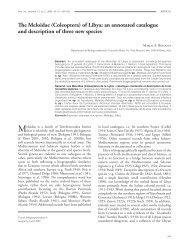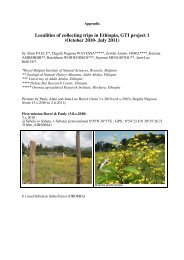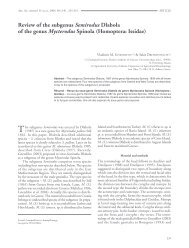New griffenfly, Bohemiatupus elegans from the Late Carboniferous ...
New griffenfly, Bohemiatupus elegans from the Late Carboniferous ...
New griffenfly, Bohemiatupus elegans from the Late Carboniferous ...
You also want an ePaper? Increase the reach of your titles
YUMPU automatically turns print PDFs into web optimized ePapers that Google loves.
Ann. soc. entomol. Fr. (n.s.), 2010, 46 (1–2) : 183-188ARTICLE<strong>New</strong> <strong>griffenfly</strong>, <strong>Bohemiatupus</strong> <strong>elegans</strong> <strong>from</strong> <strong>the</strong> <strong>Late</strong><strong>Carboniferous</strong> of western Bohemia in <strong>the</strong> Czech Republic(Odonatoptera: Meganisoptera: Meganeuridae)Jakub Prokop (1),* & André Nel (2)(1)Charles University in Prague, Faculty of Science, Department of Zoology, Viničná 7, CZ-128 44, Praha 2, Czech Republic(2)CNRS UMR 7205, Muséum National d’Histoire Naturelle, CP 50, Entomologie, 45 rue Buffon, F-75005 Paris, France* Corresponding authorAbstract. A new griffenfl y, <strong>Bohemiatupus</strong> <strong>elegans</strong> n. gen., n. sp. (Meganeuridae) is described<strong>from</strong> <strong>the</strong> Upper <strong>Carboniferous</strong> (Bolsovian) deposits of <strong>the</strong> Ovčín near Radnice in western Bohemia(Czech Republic). The new taxon based on fore- and hindwing venation is compared with <strong>the</strong> o<strong>the</strong>rmeganeurid genera. It is <strong>the</strong> fi rst record of a large griffenfl y <strong>from</strong> <strong>the</strong> continental basins of <strong>the</strong> BohemianMassif supplementing <strong>the</strong> o<strong>the</strong>r giant insects such as Bojophlebia prokopi Kukalová-Peck 1985 orCarbotriplura kukalovae Kluge 1996 <strong>from</strong> <strong>the</strong> same strata.Résumé. Une nouvelle « libellule géante », <strong>Bohemiatupus</strong> <strong>elegans</strong> du Carbonifère supérieur dela Bohème de l’ouest (République Tchèque) (Odonatoptera: Meganisoptera : Meganeuridae).Un nouveau genre et une nouvelle espèce de Meganeuridae (Meganisoptera), <strong>Bohemiatupus</strong> <strong>elegans</strong>n. gen., n. sp. est décrit du Carbonifère supérieur d’Ovčín près de Radnice (ouest de la Bohême,République Tchèque). Ce nouveau taxon est basé sur la nervation des ailes antérieures et postérieures.Il est comparé aux autres Meganisoptera décrits. Il s’agit de la première « libellule géante » des bassincontinentaux du massif de Bohème, mais pas du premier insecte géant des mêmes aire et étage(Bojophlebia prokopi Kukalová-Peck 1985, Carbotriplura kukalovae Kluge 1996).Keywords: Taxonomy, Tupindae, Insecta, Bolsovian, Radnice Basin, Paleozoic.Paleozoic odonatopteran order MeganisopteraMartynov 1932 (so-called ‘Protodonata’) represents<strong>the</strong> ‘stem group’ to true Odonata. However, <strong>the</strong>members of Meganisoptera differ <strong>from</strong> Odonata byabsence of nodus and pterostigma in wing venation,as well as males lacking secondary genitalia (Bechly etal. 2001). Above all, this group is well known for <strong>the</strong>insects with largest wingspan that have ever lived suchas Meganeuropsis permiana Carpenter 1939 <strong>from</strong> EarlyPermian of Kansas that reached wingspan more than700 mm (Carpenter 1939, 1947).The clade Odonatoptera is first recorded about320 million years ago in <strong>the</strong> Namurian, and its mainsubgroups Odonatoclada Bechly, 2003 (= <strong>the</strong> cladethat comprises <strong>the</strong> Lapeyriidae Nel et al. 1999, <strong>the</strong>Campylopteridae Tillyard 1928 and <strong>the</strong> NodialataBechly 1996 viz. <strong>the</strong> Odonatoptera with a true nodus),Meganisoptera, and Geroptera Brodsky 1994 suddenlyappeared in Westphalian (Brauckmann & Zessin 1989;Riek & Kukalová-Peck 1984; Jarzembowski and Nel2002). Meganisoptera are not very frequent in <strong>the</strong> fossilrecord of Namurian and Westphalian deposits, viz.E-mail: jprokop@natur.cuni.cz, anel@mnhn.frAccepté le 15 janvier 2010<strong>the</strong> Westphalian Carpentertypus durhami (Carpenter1960), Piesbergtupus hielscheri Zessin 2006, Arctotypusdiluculum (Whalley 1980), Palaeo<strong>the</strong>rates pennsylvanicusHandlirsch 1906, and Gallotupus oudardi Nel et al.2008; and <strong>the</strong> Namurian Sinomeganeura huangheensisProkop et al. 2008, Shenzhousia qilianshanensis Zhanget al. 2006, and Namurotypus sippeli Brauckmann &Zessin 1989 (Zessin 2006; Zhang et al. 2006; Ren etal. 2008; Nel et al. 2008, 2009).The continental basins of <strong>the</strong> Bohemian Massif arerepresented by a number of insect localities rangingin age <strong>from</strong> <strong>the</strong> Duckmantian (Westphalian B) to<strong>the</strong> Middle Stephanian. In <strong>the</strong> central and westernBohemia <strong>the</strong> most famous localities are in <strong>the</strong> RadniceMember of Bolsovian age (Wesphalian B-C), whichinvolves localities like Lubná, Příčina, Štílec, Vrapiceand Otvovice or in <strong>the</strong> Nýřany Member of <strong>the</strong> Asturianage where Nýřany and Třemošná belong among <strong>the</strong>most famous ones. Predominance of <strong>the</strong> Blattodea issignificant in Nýřany and Lubná (Kušta 1883; Fritsch1901; Handlirsch 1920; Kukalová 1955), while o<strong>the</strong>rsare represented by single records of palaeopterousinsects (Ephemeroptera, Paleodictyoptera), (Fritsch1880; Kukalová 1958; Kukalová-Peck 1985; Novák1880).183
J. Prokop & A. Nel<strong>New</strong> insect material was recently discovered atOvčín near Radnice during extensive excavations bypalaeobotanists in tuff layers so called „whetstonehorizon“ <strong>from</strong> <strong>the</strong> roof of <strong>the</strong> Lower Radnice Seam(Lower Bolsovian) with well known buried plantspreserved in situ (see Opluštil et al. 2007, 2009;Libertín et al. 2009). Insect fauna is very rare with twoo<strong>the</strong>r undescribed specimens of palaeodictyopteridlarvae and orthopteroid insect (Prokop unpubl.).Material and methodsThe fossil specimen was observed under stereomicroscopes ZeissCytoplast in dry state and under ethyl alcohol. Due to largedimensions of <strong>the</strong> specimen <strong>the</strong> venation pattern line drawingwas redrawn <strong>from</strong> color photograph and revised by parallelobservation under stereomicroscope. Drawing was finallyreadjusted to <strong>the</strong> photograph scale using of graphic software(Adobe Photoshop). Photographs were made in dry state andunder ethyl alcohol by digital camera Nikon D80 with macrolens Nikon AF-S VR Micro-Nikkor 105 mm in <strong>the</strong> highestcontrast as possible by single sided cross-light pre-exposure.Type material was collected in 2006 during extensive excavationsby group of palaeobotanists so called “Czech mafia” in Ovčinnear Radnice and housed in <strong>the</strong> collection of West BohemianMuseum in Plzeň, Czech Republic.We use <strong>the</strong> wing venation nomenclature of Nel et al. (1993),and Bechly (1996). Systematic and divisions follows <strong>the</strong> conceptof higher phylogenetic classification of Odonatoptera proposedby Bechly (1996, 2007).The venational symbols used here specified as follows: symbolsin capitals denote <strong>the</strong> longitudinal veins (CA / CP – costalanterior / posterior, ScA / ScP – subcostal anterior / posterior,RA / RP – radial anterior / posterior, IR – intercalary radialposterior, MA / MP – medial anterior / posterior, CuA / CuP– cubital anterior / posterior, AA – anal anterior).Figure 1<strong>Bohemiatupus</strong> <strong>elegans</strong> n. gen., n. sp. (Meganeuridae), holotype M00485 (negative imprint) – line drawing of fore- and hindwing venation, isolated apical partdrawn as preserved.184
<strong>New</strong> <strong>Late</strong> <strong>Carboniferous</strong> <strong>griffenfly</strong> in western BohemiaResultsSuperorder Odonatoptera Martynov 1932Order Meganisoptera Martynov 1932Family Meganeuridae Handlirsch 1906Subfamily Tupinae Handlirsch 1919Genus <strong>Bohemiatupus</strong> n. gen.Type species. <strong>Bohemiatupus</strong> <strong>elegans</strong> n. sp.Etymology. Composite name after Bohemia (historical regionin central Europe, occupying <strong>the</strong> western two-thirds of <strong>the</strong>traditional Czech Lands, currently <strong>the</strong> Czech Republic) andTupus (genus name), masculine in gender.Diagnosis. ScA short; ‘subnodus’ present between RA and RPnear base of RP2; parts of CuA and CuP between MP and AAseparated and oblique, with only one cells between <strong>the</strong>m; AA1with posterior branches; CuP very long and straight, with morethan three concave branches, but area covered by posteriorbranches of CuP distinctly narrower than those of CuA andAA1; hind wing distinctly broader and with anal and cubitoanalareas distinctly broader than in forewing.<strong>Bohemiatupus</strong> <strong>elegans</strong> n. sp.(Figs. 1–4)Holotype. Specimen M00485, well preserved basal and medialpart of fore- and hindwing, apical part of fore wing distortedand medioapical part of hindwing not preserved, negativeimprint, collection of West Bohemian Museum in Plzeň, CzechRepublic.Figures 2–4<strong>Bohemiatupus</strong> <strong>elegans</strong> n. gen., n. sp. (Meganeuridae), holotype M00485 (negative imprint). 2, photograph of wing venation, ventral view; 3, detail photographof basal part of forewing; 4, detail photograph of forewing isolated apical part.185
J. Prokop & A. NelDerivation of name. Named after magnificent state ofpreservation, <strong>elegans</strong> in Latin.Type locality. Ovčín opencast mine near Radnice,Radnice Basin, Czech RepublicType strata. Upper <strong>Carboniferous</strong>, Westphalian B-C,Bolsovian, Kladno Formation, Radnice Member, LowerRadnice Coal, Whetstone Horizon.Description. Negative imprint of a fore and ahindwing in life position, probably hyaline. Forewingbroadest part at about midwing; length of fragmentto first distortion break about 115 mm, probable totallength about 260 mm; wing width 49 mm; estimateratio (wing length/width) about 5.3; precostal area ofCA and CP not preserved, but ScA is certainly shortas it is absent above arculus level; simple concave ScPnearly parallel to anterior wing margin, and reaching itin apical part of wing, at least distal of 190 mm <strong>from</strong>wing base, but extreme apex of ScP not preserved; ninevisible ‘antenodal’ cross-veins in area between ScP andC, more or less aligned with cross-veins in area betweenScP and RA; <strong>the</strong> most basal cross-vein perpendicular toC, ScP, and RA, stronger than o<strong>the</strong>rs ‘antenodals’, andmaking a distinct brace corresponding to <strong>the</strong> primaryantenodal cross-vein Ax0 not preserved; ‘subnodus’between RA and RP near base of RP2; stem of radialveins dividing 34 mm <strong>from</strong> wing base forming ‘arculus’,RA strong, simple, parallel to ScP, and ending probablyin wing apex; R and MA fused in <strong>the</strong>ir basal parts; RPbifurcating into RP1/2 and RP3/4 88 mm <strong>from</strong> wingbase; only basal part of RP3/4 preserved, simple; IR2and o<strong>the</strong>r distal branches of RP partly preserved onisolated apical part; MA nearly straight with its mostbasal posterior branches partly preserved, first oppositebifurcation between RP1/2 and RP3/4; only fragmentsof MP vein preserved and visible at level of arculus,its medial part being hidden under rock, but MPprobably simple; at least CuA forming strongly obliquecross-vein but remains of an oblique cross-vein CuPalso visible in area between MP and AA, CuP 15 mm<strong>from</strong> wing base, CuA one cell distally; CuP separating<strong>from</strong> CuA 36 mm <strong>from</strong> wing base and six cells distal ofCuP-crossing; distal part of CuA with numerous mainposterior branches; CuP very long and ra<strong>the</strong>r straight,with four main simple posterior branches covering arelatively small area, basal part before its first furcationlong and straight, about 4 mm long, width of area ofCuP along posterior wing margin 51 mm; distal partof AA forming a relatively large are, width of this arealong posterior wing margin 49 mm; basal part of AA(+ Cu) forming a very weak curve; anal and cubitoanalareas ra<strong>the</strong>r broad, 17 mm wide, with numerousposterior branches.The preserved parts of <strong>the</strong> hindwing are verysimilar to <strong>the</strong> forewing in pattern of venation exceptfor <strong>the</strong> cubito-anal area, hindwing slightly broaderthan forewing; length of wing fragment about 85 mm,probable total length as about fore wing; wing width50 mm; estimated ratio (wing length/width) 5.2; analand cubito-anal areas distinctly broader than in <strong>the</strong>fore wing, 30 mm wide; preserved basal part of CuPlong and nearly straight but distal part not preserved;distal part of AA forming a relatively large area with8–9 main posterior branches.DiscussionThis Odonatoptera is clearly related to <strong>the</strong>Meganisoptera that comprises <strong>the</strong> ‘families’Namurotypidae Bechly 1996, MeganeuridaeHandlirsch 1906, Kohlwaldiidae Guthörl 1962, andParalogidae Handlirsch 1906. Relationships with <strong>the</strong>Namurotypidae are excluded because <strong>Bohemiatupus</strong>n. gen. has a distally branched CuP, instead of beingsimple. The Paralogidae have a long and straight CuP asin <strong>Bohemiatupus</strong> n. gen., but with numerous branchescovering a broader area than CuA and distal branchof AA. The Kohlwaldiidae are characterized by having<strong>the</strong> distal parts of CuP and AA strongly reduced,which is not <strong>the</strong> case of <strong>Bohemiatupus</strong> n. gen. (Nel etal. 2009). The Meganeuridae are characterized by <strong>the</strong>presence of a typical ‘subnodal’ oblique vein betweenRA and RP near <strong>the</strong> base of RP2, which is preservedin our fossil. The very large size of <strong>Bohemiatupus</strong> n.gen. supports affinities with this family even if severalMeganeuridae have distinctly smaller dimensions(Nel et al. 2009). <strong>Bohemiatupus</strong> n. gen. cannot beattributed to <strong>the</strong> Meganeurinae because its vein ScA isshort. The Carpentertypinae Zessin 1983 [type genusCarpentertypus Zessin 1983, based on one speciesC. durhami (Carpenter 1961)] is based on a veryfragmentary fossil, with no information on any of <strong>the</strong>basal halves of <strong>the</strong> wings. Never<strong>the</strong>less it differs <strong>from</strong><strong>Bohemiatupus</strong> n. gen. in its distinctly less numerous cellsand narrower area covered by MA. The PiesbergtupinaeZessin 2006 (type genus Piesbergtupus Zessin 2006) ischaracterized by <strong>the</strong> narrow anal area of fore wing andpresence of one oblique cross-vein distal of <strong>the</strong> obliquebraces CuP and CuA and basal of <strong>the</strong> distal branch ofCuP re-emerging <strong>from</strong> CuA+CuP, plus <strong>the</strong> long CuPand AA1 (Zessin 2006, 2008; Nel et al. 2009). Thepattern of wing venation of <strong>Bohemiatupus</strong> n. gen. fitsvery well with <strong>the</strong> Tupinae. The monophyly of this lastgroup is not very clearly established (Bechly 1996; Nelet al. 2009), but we can now restrict <strong>the</strong> comparison of<strong>Bohemiatupus</strong> n. gen. to <strong>the</strong> genera that are currentlyattributed to it. After <strong>the</strong> key to <strong>the</strong> tupine genera ofNel et al. (2009), <strong>Bohemiatupus</strong> n. gen. would fall186
<strong>New</strong> <strong>Late</strong> <strong>Carboniferous</strong> <strong>griffenfly</strong> in western Bohemianear <strong>the</strong> Permian genus Tupus Sellards 1906 becauseof <strong>the</strong> following characters: <strong>the</strong> two braces CuP andCuA oblique, not fused into a long, oblique vein; AA1with several posterior branches; and CuP with morethan three concave branches. <strong>Bohemiatupus</strong> n. gen.greatly differs <strong>from</strong> Tupus in its hindwing cubito-analarea distinctly broader than that of fore wing. Some‘enigmatic’ genera are based on incomplete wings, i.e.<strong>the</strong> <strong>Carboniferous</strong> genera Shenzhousia Zhang et al.2006 and Boltonites Handlirsch 1919, and <strong>the</strong> PermianPetrotypus Zalessky 1950. Petrotypus needs a completeredescription, and it is based on a very poor fossil.Never<strong>the</strong>less, its CuP seems to be simple and verystraight after Zalessky (1950), unlike <strong>Bohemiatupus</strong> n.gen. Shenzhousia shares with <strong>Bohemiatupus</strong> n. gen. avery long and straight CuP but with numerous posteriorbranches covering a broad area, unlike <strong>Bohemiatupus</strong>n. gen. (Zhang et al. 2006). After <strong>the</strong> figure of Bolton(1922: fig. 44), Boltonites has a distinctly curved CuP,shorter than that of <strong>Bohemiatupus</strong>.Conclusions<strong>Bohemiatupus</strong> n. gen. is established for <strong>Bohemiatupus</strong><strong>elegans</strong> n. sp. (type species) that exhibits uniquecombination of characters within Meganeuridae. Thepresent discovery represent <strong>the</strong> first record of large<strong>griffenfly</strong> <strong>from</strong> <strong>the</strong> continental basins of <strong>the</strong> BohemianMassif supplementing <strong>the</strong> o<strong>the</strong>r giant insects suchas Bojophlebia prokopi Kukalová-Peck 1985 orCarbotriplura kukalovae Kluge 1996 <strong>from</strong> <strong>the</strong> samestrata.Moreover, <strong>the</strong> material <strong>from</strong> Ovčín near Radnicerepresents an extraordinary source of fossil plants in situand o<strong>the</strong>r animals like arachnid, fish and amphibiantrace fossils those enable study of developed peatmire ecosystem into a shallow lake gradually filled byredeposited volcanic ash <strong>from</strong> Bolsovian of westernBohemia (Czech Republic).Acknowledgements. The authors are grateful to Radek Labuťa(National Museum in Praha) who discovered <strong>the</strong> present specimenand to group of <strong>the</strong> Czech paleobotanits so called “Czechmafia” for large excavations at Ovčín locality. We especiallythank to Josef Pšenička (West Bohemian Museum in Plzeň) for<strong>the</strong> loan of <strong>the</strong> material. The first author (JP) acknowledges <strong>the</strong>research support <strong>from</strong> <strong>the</strong> Grant Agency of Academy of <strong>the</strong>Czech Republic No. KJB301110701 and Ministry of SchoolsMSM 0021620828. We sincerely thank Dr Gun<strong>the</strong>r Fleck forhis useful comments on <strong>the</strong> first version of <strong>the</strong> paper.ReferencesBechly G. 1996. Morphologische Untersuchungen am Flügelgeäder derrezenten Libellen und deren Stammgruppenvertreter (Insecta; Pterygota;Odonata), unter besonderer Berücksichtigung der PhylogenetischenSystematik und des Grundplanes der Odonata. Petalura BöblingenSpecial Volume 2: 1-402.Bechly G. 2007. Phylogenetic systematics of Odonata. Homepage on Internet.http://www.bernstein.naturkundemuseum-bw.de/odonata/index.htmBechly G., Brauckmann C., Zessin W., Gröning E. 2001. <strong>New</strong> results concerning<strong>the</strong> morphology of <strong>the</strong> most ancient dragonflies (Insecta: Odonatoptera)<strong>from</strong> <strong>the</strong> Namurian of Hagen-Vorhalle (Germany). Zeitschriftfür Zoologische Systematik und Evolutionsforschung 39: 209-226.Bolton H. 1922. A monograph of <strong>the</strong> fossil insects of <strong>the</strong> British coalmeasures. Palaeontographical Society Monograph London 74: 81-156.Brauckmann C., Zessin W. 1989. Neue Meganeuridae aus dem Namuriumvon Hagen-Vorhalle (BDR) und die Phylogenie des Meganisoptera.Deutsche Entomologische Zeitschrift (N.F.) 36: 177-215.Carpenter F. M. 1939. The Lower Permian insects of Kansas. Part 8. AdditionalMegasecoptera, Protodonata, Odonata, Homoptera Psocoptera,Plecoptera, and Protoperlaria. Proceedings of <strong>the</strong> American Academy ofArts and Sciences 73: 29-70.Carpenter F. M. 1947. Lower Permian insects <strong>from</strong> Oklahoma. Part 1. Introductionand <strong>the</strong> orders Megasecoptera, Protodonata, and Odonata.Proceedings of <strong>the</strong> American Academy of Arts and Sciences 76: 25-54.Fritsch A. 1880. Dva noví členovci z útvaru kamanouhelného v Čechách [Twonew arthropods <strong>from</strong> <strong>the</strong> coal system in Bohemia.]. Vesmir 9: 241-242.Fritsch A. 1901. Fauna der Gaskohle und der Kalksteine der PermformationBöhmens. Bd. IV, Prag, 92 pp.Handlirsch A. 1920. Beiträge zur Kenntnis der Palaeozoischen Blattarien.Sitzungberichte der Akademie der Wissenschaften, Ma<strong>the</strong>matisch-Naturwissenschaftliche Klasse, Wien, (1), 129: 8.Jarzembowski E. A., Nel A. 2002. The earliest damselfly-like insect and <strong>the</strong>origin of modern dragonflies (Insecta: Odonatoptera: Protozygoptera).Proceedings of <strong>the</strong> Geologist’s Association 113: 165-169.Kukalová J. 1955. Permoedischia n. gen. (Protorthoptera) a Moravipteran. gen. (Palaeodictyoptera) z moravskeho permu. Sborník ÚstředníhoÚstavu Geologického, oddil Paleontologický 21: 541-575.Kukalová J. 1958. Paoliidae Handlirsch (Insecta, Protorthoptera) aus demOberschlesichen Steinkohlenbecken. Geologie 7: 935-959.Kukalová-Peck J. 1985. Ephemeroid wing venation based upon new gigantic<strong>Carboniferous</strong> mayflies and basis morphological phylogeny andmetamorphosis of pterygopte insects (Insecta, Ephemerida). CanadianJournal of Zoology 63: 933-955.Kušta J. 1883. Über einige neue böhmische Blattinen. Sitzungberichte KoniglicheBöhmische Gesellschaft Wissenschaften, Pragae 1883: 211-215.Libertín M., Opluštil S., Pšenička J., Bek J., Sýkorová I., Dašková J.2009. Middle Pennsylvanian pioneer plant assemblage buried insitu by volcanic ash-fall, central Bohemia, Czech Republic. Review ofPalaeobotany and Palynology 155(3-4): 204-233.Nel A., Garrouste R., Roques P. 2008. A new <strong>griffenfly</strong> genus <strong>from</strong> <strong>the</strong><strong>Late</strong> <strong>Carboniferous</strong> of nor<strong>the</strong>rn France (Odonatoptera: Meganeuridae).Insect Systematics & Evolution 39: 231-239.Nel A., Fleck G., Garrouste R., Gand G., Lapeyrie J., Bybee S. M.,Prokop J. 2009. Revision of Permo-<strong>Carboniferous</strong> griffenflies (Insecta:Odonatoptera: Meganisoptera) based upon new species andredescription of selected poorly known taxa <strong>from</strong> Eurasia. Palaeontographica(A) 289: 89-121.Nel A., Martínez-Declòs X., Paicheler J.-C., Henrotay M. 1993. Les‘Anisozygoptera’ fossiles. Phylogénie et classification (Odonata).Martinia Numéro Hors Série 3: 1-311.Novák O. 1880. Ueber Gryllacris Bohemica, einen neuen Locustiderenrestaus der Steinkohlenformation von Stradonitz in Böhmen. Jahrbuch derk.k. Geologischen Reichsanstalt 30: 69-75.Opluštil S., Pšenička J., Libertín M., Šimůnek Z. 2007. Vegetationpatterns of Westphalian and Lower Stephanian mire assemblages preservedin tuff beds of <strong>the</strong> continental basins of Czech Republic. Reviewof Palaeobotany and Palynology 143: 107-154.Opluštil S., Pšenička J., Libertín M., Bashforth A. R., Šimůnek Z.,Drábková J., Dašková J. 2009. A Middle Pennsylvanian (Bolsovian)peat-forming forest preserved in situ in volcanic ash of <strong>the</strong> WhetstoneHorizon in <strong>the</strong> Radnice Basin, Czech Republic. Review of Palaeobotanyand Palynology, 155 (3-4): 234-274.187
J. Prokop & A. NelRen D., Nel A., Prokop J. 2008. <strong>New</strong> early <strong>griffenfly</strong>, Sinomeganeurahuangheensis <strong>from</strong> <strong>the</strong> <strong>Late</strong> <strong>Carboniferous</strong> of nor<strong>the</strong>rn China(Meganisoptera: Meganeuridae). Insect Systematics & Evolution 38:223-229.Riek E. F., Kukalová-Peck J. 1984. A new interpretation of dragonflywing venation based upon Early <strong>Carboniferous</strong> fossils <strong>from</strong> Argentina(Insecta: Odonatoidea) and basic characters states in pterygote wings.Canadian Journal of Zoology 62: 1150-1166.Zalessky G. 1950. [<strong>New</strong> representatives of fossil insects of order Protodonata.]Byulleten Moskovskogo obshchestva ispytatelej Prirody, otdel Geologicheskii25: 98-108. [in Russian].Zessin W. 2006. Zwei neue Insektenreste (Megasecoptera, Odonatoptera)aus dem Westfalium D (Oberkarbon) des Piesberges bei Osnabruck,Deutschland. Virgo, Mitteilungsblatt des Entomologischen VereinsMecklenburg 9: 37-45.Zessin W. 2008. Überlick über die paläozoischen Libellen (Insecta, Odonatoptera).Virgo, Mitteilungsblatt des Entomologischen Vereins Mecklenburg11: 5-32.Zhang Z.-J., Hong Y.-C., Lu L.-W., Fang X.-S., Jin Y.-G. 2006. Shenzhousiaqilianshanensis gen. et sp. nov. (Protodonata, Meganeuridae), a giantdragonfly <strong>from</strong> <strong>the</strong> Upper <strong>Carboniferous</strong> of China. Progress in NaturalScience 16: 328-330.188



